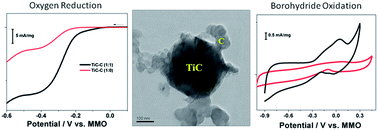Synergistic electrochemical activity of titanium carbide and carbon towards fuel cell reactions†
Abstract
Titanium carbide (TiC) is an electrically conducting refractory interstitial compound possessing several unique properties. A cost-effective, efficient and non-Pt electrocatalyst based on TiC is explored and the multi-functionality of TiC towards various electrochemical reactions that are of significant interest in low temperature fuel cells is studied. Ameliorated activities towards oxygen reduction reaction (ORR) and borohydride oxidation are observed with TiC–carbon composites. High sensitivity and selectivity towards ORR have been demonstrated with very good methanol tolerance. The charge transfer interactions between TiC and carbon seem to play a vital role in the improved activity as compared to their individual counterparts. The present study opens up a way to realize completely Pt-free borohydride fuel cell architecture.


 Please wait while we load your content...
Please wait while we load your content...